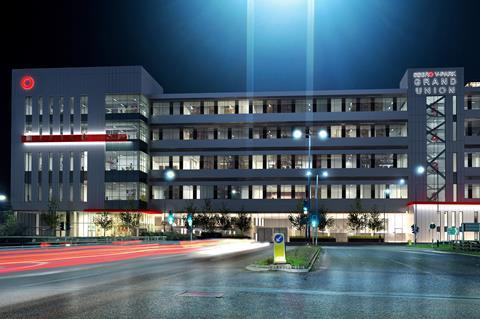Firm clarity is needed in the logistics market between what is a multi-level and a multi-storey shed. They are not one and the same, interchangeable jargon, but different animals in the evolving logistics market.

“Multi-storey is divisible vertically and horizontally for different occupiers and is a very new and relatively untested concept in Europe,” explains Marcus de Minckwitz, EMEA head of I&L at Savills. “Multi-level warehousing, where one occupier operates a warehouse over different levels, is a relatively common thing. Think Amazon.”
The distinction is important as the UK logistics sector stands on the cusp of a multi-storey revolution coming on the back of last month’s announcement of the 50:50 JV by St George and SEGRO to build their first such UK scheme.
Called SEGRO V-Park Grand Union, the 134,500 sq ft of light industrial space will be spread over six storeys with up to 20 individual units of varied size, shared meeting rooms, breakout areas and wellness spaces and a green roof terrace. Potential tenants are parcel delivery companies, supermarket retailers, fashion retailers and food and drink businesses. This is a world away from multi-level, Amazon-style development with internal ramps and mezzanines.
Development will start next summer and forms part of Grand Union in Brent, north-west London, where more than 3,000 homes will be built in Alperton by St George. Location wise, it is in a sweet spot near Tudor Estate and Premier Park at Park Royal and will front on to the North Circular (A406), on the former Northfields Industrial Estate – now an SIL site.
Definitions aside, what SEGRO is creating is distinctive in being the first of its kind in the UK, and only the second in Europe – the other being Paris Air2 Logistique, in Paris, another SEGRO creation. Shed-heads can rightly highlight the 234,000 sq ft X2 at Heathrow, which took eight years to fully lease. It was built by Brixton Estates in 2008, before being inherited by SEGRO when it bought Brixton in 2009, and was last month part of a £345m of industrial assets swap with Schroders.
We are experiencing market conditions never before seen, overlaid against structural changes
John Allan, Avison Young
The difference, however, is age, height and sustainability: “X2 is 15 years old, and while technically multi-level, is just two levels. [SEGRO V-Park] is six levels and the first of a modern generation embracing the latest tech and sustainability features,” says a SEGRO spokesperson.
With the market watching closely, especially investors and occupiers, the SEGRO V-Park Grand Union model is being hailed as an answer to London’s restricted land supply and squeeze on land values driving the need for further intensification.
Lost land
Over the past decade, the capital has lost around 100ha of industrial land annually, according to the Greater London Authority’s (GLA’s) Industrial Land Demand report. Southwark alone predicts a 45% drop in industrial land, from 80ha to 50ha, to satisfy a pledge to deliver 20,000 new homes in the area by 2037.
“We are experiencing market conditions never before seen, overlaid against the structural changes in the fabric of retail and the procurement of goods and services,” says John Allan, director of industrial sales and leasing at Avison Young.

SEGRO V-Park Grand Union: the first of its kind in the UK
“Brownfield land and the supply of industrial accommodation in the capital has been eroded in favour of alternative uses such as residential. The current London Plan goes some way towards protecting the supply; it does allow for further dilution in terms of co-location and intensification, which in part gives rise to the potential need for multi-storey facilities in certain locations.”
London has 55 strategic industrial locations, with the mayor’s London Plan explicitly seeking to ensure enough modern logistics, homes and businesses across the capital. “At [Grand Union] you are seeing a real evolution, where B1 light industrial use can be modernised and multi-layered within an urban setting,” says Faraz Baber, operations director, Midlands and South East, at RPS. Baber started on Grand Union as an adviser with former employer Terence O’Rourke, before moving to RPS, while being retained as an adviser.
Baber hails the development as being perfect in terms of the location and co-operation between the London Borough of Brent, City Hall, SEGRO and St George. “SEGRO V-Park is a solution that’s been worked up to look at how a site can provide different tier levels of users to operate from one building in a way that provides enough modern space and setting for them to be able to deliver the services they require while working within the fabric of a wider development.”
Multi-storey may be the answer to the high land values and constrained spaces, but it’s not a clear case of ‘build it and they will come’. “If you go to an occupier and you talk about sharing space, they get very nervous around [the likes of] business risk and security,” says Jonathan Priestley, senior director and head of UK advisory and transaction occupier services, I&L, at CBRE.
It is still early days in the evolution of multi-storey buildings in the UK. We’re going to watch this space
Colin Godfrey, Tritax Big Box REIT
“I don’t think those risks are factual.
They are based on historical thinking, on what occupiers trust and are used to. Some are nervous about breaking new ground.”
Priestley adds that if there is an alternative to get the same square footage relatively nearby, “they will always go to that because of the perceived risks”.
Bridget Outtrim, director in Savills’ I&L team, agrees that occupiers’ first option would be a conventional unit. As such, she says:
“A developer will only be confident putting a multi-storey scheme into an area where there isn’t much choice around it… where supply is so tight the occupiers will have to go there.”
Whether it will be anywhere in the UK apart from the capital is doubtful. London and Paris are frequently cited as the only two European cities that really require true urban logistics. “We agree with that,” says Colin Godfrey, chief executive officer at Tritax Big Box REIT. “Every other city you can strike to the heart of from a 20-minute drive time from the orbital. Even In London, a large part of the last mile is largely going to be fulfilled from that orbital, or the home counties.”
Multi-storey discussions
But there is no doubt that multi-storey is going to take off in London. “My understanding is there are discussions with other providers who are looking very closely to this type of model,” says Baber.
It is expected to take a long time to take off, however, as the market watches what happens at Grand Union. “It is still early in the evolution of multi-storey buildings in the UK and we’re going to watch this space before we make any positions on it,” says Godfrey.
Even SEGRO, which is leading the multi-storey charge, is being cautious about future developments. “[We] typically allow a period for the building to let up and we’ll review its success going forward,” says Alan Holland, managing director of greater London at SEGRO. “We probably have a small number of similar opportunities we are looking at in London and the South East. There are a couple of London boroughs where it might work, but we haven’t signed or sealed anything just yet.”
Outtrim is confident SEGRO will succeed with its scheme. “It’s time [multi-storey] was built, and that we watched it progress through the market, and we certainly wish SEGRO well with it – it’s an experiment for them. They should be confident because they are the masters of the west London industrial market and understand the dynamics better than anyone: they can see the constraints those the occupiers are under [in London].”
The rest of the sector will be watching closely to see where SEGRO’s experiment leads. “It’s a case of [let’s] see what else flows from it,” says Outtrim.
The investor angle
There is investor appetite for multi-storey developments, but Jack Farmer, head of UK I&L capital markets at CBRE, says: “What’s holding investors back is the only people pushing the button on buildings are the developers.
“We haven’t seen a developer seeking a single asset funding deal on a multi-storey asset. And there’s no secondhand trade market completed to stabilised investments either.”
Developers who don’t have their own money are being constrained by the increasing value of single-storey buildings: “Where the market has got to on those is just so competitive that it’s quite a big decision to go and do a multi-storey,” continues Farmer.
“Everyone is talking about [multi-storey as] space is at a premium, so intensification is the obvious way to go, and we are all watching people like SEGRO, ProLogis, GLP, British Land – someone is going to do this at scale, but will they trade it? Probably not… Those working and looking at the multi-storey format are long-term holders. In terms of the investment market being fully engaged in multi-storey, it feels it is a long way off.”
In 2018, Gazeley (now GLP announced it intended to develop a 426,000 sq ft multi-storey warehouse over three levels in east London at Silvertown, called G Park London Docklands. The distribution hub is still going through the planning process.
Farmer says that if developers were to complete a multi-storey building like G Park and then let or part-let it and put it on the market, “investors would love an opportunity to look at it”.
According to Mark Snow, senior development director at St Modwen Logistics, investors’ interest should be no different than to single-storey industrial.
“The key criteria will still be the strength of the lease terms and covenants. The initial schemes are also likely to be scrutinised on their design and future flexibility, and developers will need to ensure that the structure is fit for several uses,” he adds.
I&L space shortage points to an uncertain future
- 1
- 2
- 3
- 4
- 5
- 6
 Currently reading
Currently readingA whole other storey
- 7
- 8
- 9








































No comments yet